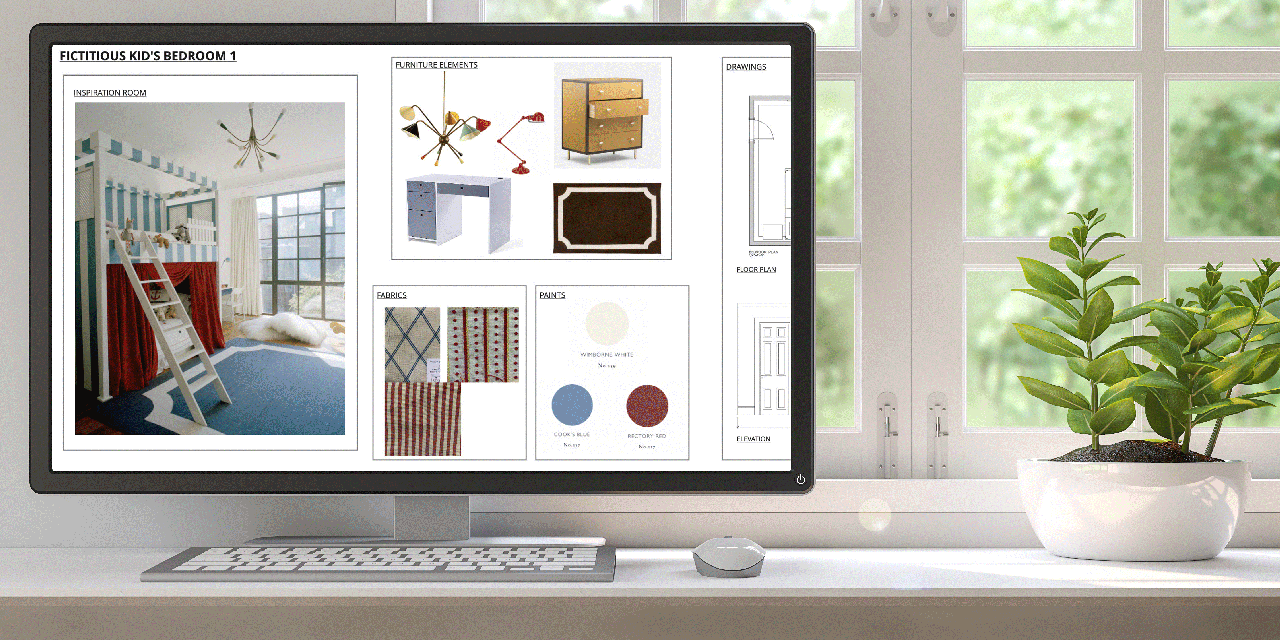Even designers who are adept at delivering client presentations have had to modify their strategies for the new sheltering-in-place reality. Now, digital methods reign supreme. However, selling a design scheme and trying to dissect complicated plans over the computer is not an easy task for even the most tech savvy. AD PRO asked four interior designers who have landed new business since lockdown orders took effect to explain their techniques for delivering a stellar digital client presentation.
Adequate preparation is the first rule of any successful client presentation. But being overly prepared is that much more important when you’re not able to explain your pitch face to face. “Digital presentations require a lot more preparation,” says AD100 designer Virginia Tupker. One category that requires extra prep work is materials. “I think it is important that the client has a set of the materials that you are discussing, as it is so hard to tell from photos,” Tupker continues. “We send a package preceding the meeting so that we are all on the same page.”
Interior designer Chiara de Rege has a similar strategy. “Fabrics and finishes can be scanned and uploaded, but they are never fully realized digitally,” she says. “I tend to like to send the fabrics and swatches of finishes like wood or tiles to the clients to hold while we are doing the digital presentation.”
As part of the preparation, be sure to email an agenda in advance so that clients understand what will be covered in the meeting. “Set aside adequate time,” says James “Ford” Huniford, founder of Huniford Design Studio. “Working this way is a different process, and it can take longer than usual to convey the information.”
Andrew Torrey, founder and principal designer at BA Torrey, agrees. “You need to have a very clear directive for what you want to achieve on the call,” he says. “That program should be conveyed to the client, so they aren’t disappointed when they expect something else or are unprepared to discuss what you are presenting.”
While video conferencing software like Zoom, Google Meet, or Microsoft Teams is essential, designers have been pushing the envelope further with programs that bring their presentations to life. Tupker has discovered a program called Miro, which allows users to create a virtual presentation board that can be shared during video conferences. “It has been a lifesaver!” she says. “It also allows my team to collaborate in real time as we prepare for the presentation.”
Torrey says his firm will share SketchUp or CAD files in meetings held on Zoom and GoToMeeting. “By presenting in full AutoCAD, followed by SketchUp, we enable our clients to virtually walk through their home in a digital landscape. It’s an unbelievably effective way of engaging clients and encouraging them to have ownership of every detail of their home.” The firm has also started rendering custom furniture in Rhino, which has “taken our furniture drawings to another level,” he says.
Of course, nailing a successful digital presentation is all about the visuals. “Great visuals are a must to convey and sell your ideas effectively,” Tupker says. When you can’t be there to express your ideas in person, your photos, sketches, mood boards, and samples must speak volumes, so take care to make your visuals outstanding.
“When possible, upload renderings or sketches of the rooms with selected items so clients can see the big picture—including the furniture pieces, rugs, lighting. And make sure it is clear where everything is going, even if it means using arrows to designate where the sofa is going or a credenza,” suggests de Rege. “Don’t assume the clients can read floor plans or automatically see your vision. I really have to spell things out for them in order for the digital presentation to go smoothly.”
Torrey adds that his team has had success relying on full 3D renderings made in Rhino and SketchUp. “It’s a way for our clients to engage and enjoy the design process, as well as see their home in elevation and 3D rotation,” he explains.
While the lack of in-person interaction is the greatest challenge when delivering a digital presentation, virtual proposals have distinct benefits. “One component that is unique to a digital meeting is reviewing the CAD drawing live with the client, which is not something we would normally get to do,” Huniford says.
Tupker appreciates how the entire team—client, architect, and designer—can all be present, and there is no time wasted traveling to the meeting. And while Torrey acknowledges he misses the face-to-face dialogue, he adds, “My clients and my team are quickly adapting to this new way of working and, dare I say it, are becoming exponentially more productive and enjoying the process.”
